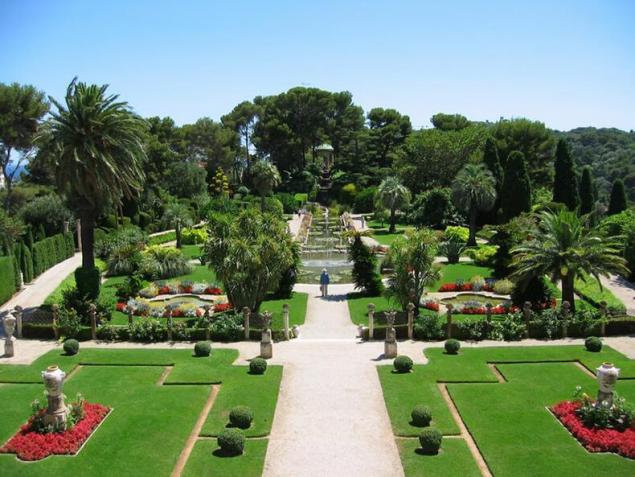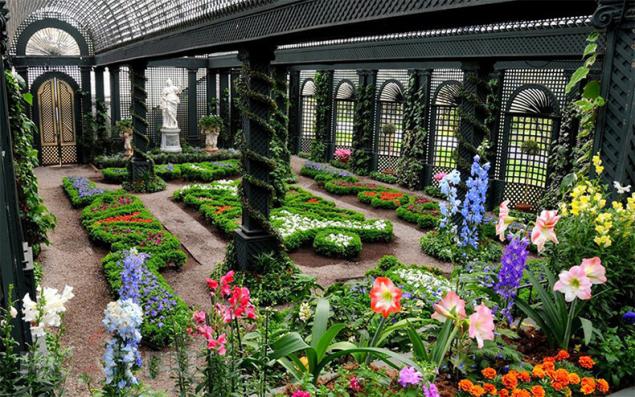815
Moorish style: ideas for your garden
About delights of Moorish gardens knows anyone who is even slightly in contact with Arab culture. Full southern charm, these gardens are designed to remind man of the paradise of pleasure, of the repose of the soul. Talk about hot and beautiful East.
Where beautiful garden blooms where nightingales
Gentle sing than the nightingale of the East?
Abulkasim Lakhuti

History
Moorish style in the design of gardens gained worldwide popularity rather late - only in the nineteenth century. It was formed in Spain, which for many years was conquered by the Moors - Muslim conquest of the Iberian Peninsula - the Arabs and Berbers. In medieval Europe, Islamic rulers built numerous gardens, designed to recall the oases of native lands.
Although modern Moorish style came from Spain, there are strong features of traditional Arab culture, the influence of the Koran, especially the Muslim aesthetics. Therefore, the concept of "Moorish Garden", "Islamic Garden", "Islamic garden", "Oriental Garden" are often used interchangeably.
Philosophy and characteristics
Moorish gardens, created in the image of the ancient oasis, a place symbolizing heavenly repose, a blissful refuge in the desert, where the exhausted traveler seeks with all his heart. Only there it can afford to rest, enjoy the cool shade of the murmur of flowing streams and quiet. News for this day, is not it?

The English word paradise - paradise comes from the ancient Persian pairidaēza, which translates to an enclosed space or park. Paradeisos Greek word from the same root came to mean not only the Persian landscape delights, but also the garden of Eden, and the heavens, and the state of supreme bliss. This delight embodied in the form of a perfect garden, the Qur'an promises rewards as orthodox. There will be a "source, fruit and pomegranates," "sources, spurting water" and "cool pavilions».
Since the Moorish garden - a successor of the oases, and even a "little piece of heaven on earth", it always contains lush vegetation, an abundance of colors and life-giving water
. Podmoskovnie gardeners certainly appreciate not typical for our climate brilliance and pomp Moorish garden, because it is always very bright, unusual, literally surrounded by trees. To achieve such a luxury, it is not necessary to chase rare pets botanical gardens. The required effect is achieved by combining the plant, which is hardly exotic.
It is important to choose varieties that provide persistent spicy aroma. Amiss widely known basil, sage, clove and peppermint. You can find a replacement vegetation warm countries. For example, instead of cypress trees planted columnar arborvitae, instead of olive - Elaeagnus silver or sea buckthorn, instead of boxwood - cotoneaster
. For suburban area Moorish garden is convenient because it easily fits not that in six, but two or three acres. It will look great in the front area, but if there is no place to become a secret oasis in the backyard, hidden from indiscreet looks of passers-by.
Another advantage of the Moorish garden - it does not require regular professional care. Everything there is allowed to grow naturally, without cutting or shearing to make the strict geometric shapes. Planting is also not regulated, you can experiment with different fruit and ornamental plants.
But when planning a garden need a clear scheme. In the center of the square or elongated from north to south of the rectangle to be a pond - a small pond or pool, or better yet elegant fountain with a weak pressure. Why weak? It's very simple - the water in the eastern countries is priceless, for the sake of economy in all water bodies in the garden of her flowing streams thin and does not hit the high jets
. The edges of the pond is recommended to revet glass, mosaics, marble, tiles or decorative stone, which then should be covered with a glossy varnish. The interior surfaces to create the traditional flavor is better to lay a greenish-blue tiles. And the pond itself and the water is always clean. Aquatic plants are not used.
Ideally, you should see the pond from any part of the garden, so it is better not to surround thrive bushes and tall trees.
From the pond in a Moorish garden symmetrically depart four paved paths or the channel of the stream. They divide the space into four equal parts the correct form, and if the area of the garden allows, these sectors and in turn, another member of the four equal parts. This principle is called the plan "chor-Bagh" - the Arabic version of our words "four garden»
. However, in the gardens of the Spanish Muslim type strict geometric canons often replaced with more free lines. Therefore, in the Moorish gardens you can see the "chaotic" patios - the so-called patio. They are designed for outdoor activities without any coating from the weather.
Transitions from one part of the garden in a different light decorated arches and pergolas, vertical blinds, entwined with flowering vines. Generally, the vines will be very appropriate, not cost neglect and famous all cottagers plants like clematis, honeysuckle, magnolia, and ordinary Chinese girl's grapes. Particularly impressive twine plants look rough on a bright background. Keep this in mind when choosing ways to finish the facade of a house or a solid fence. By the way, a Moorish garden - a closed space, requiring solid walls
. A place of honor is given to the Moorish garden under a rose garden. Usually it is satisfied with the close of the pond. Because the East is highly prized and fragrant plants, preference is given to varieties of roses, famous for its aroma.
To create a Mediterranean flavor in the facing of retaining walls and garden benches used majolica saturated colors -. Blue or dark blue, yellow, green, white, gold and terracotta
Decorative garden paving is intended to remind richly ornate oriental rug and carried out with the use of colored stone or glazed tile. The motives for the patterns can serve as stylized ferns, pine cones, pomegranates and vines. Tiles designed for paving, it is better to choose a white or yellow.
Specific European parks sculptures and busts in the Moorish gardens of place, because Islam prohibited images of people and animals.
Garden Luxury emphasize comfortable wooden or stone bench with colorful cushions in Oriental style.
Moorish lawn
Since the Islamic landscaped style was formed in the arid countries, familiar to our eyes cereal lawn virtually unused. In traditional Islamic gardens of the earth is covered with geometrically precise pattern paving stone or glazed tile. In Europe, mixborders in the Moorish style is composed mainly of low-growing drought-tolerant plants that differ abundant flowering and preferably lasting fragrance.
Grass-flower lawn is odnokolernym or variegated. Seeds can be purchased at a ready mix or choose themselves. In the latter case, take note of the five rules:
1. All plants must be suitable for our climate.
2. All the plants have to be stunted.
3. Flower in the grass should not be more than 20%. As a basis bentgrass fit well ordinary, annual ryegrass, Kentucky bluegrass.
4. Do not ignore cereals (such as Agrostis capillaris and red fescue).
5. Before planting the seeds should be mixed with sand in a ratio of 1:. 3
Select at least a dozen hardy crops, flowering at different times, and combine well with each other. Because it can be annuals blue flax, carnation Chinese, Nemesia, eschscholzia, calendula, cornflower, snapdragons, toadflax, viola, brahikoma, datura, Mattioli, Nigella. Of perennials should pay attention to the Papaver rhoeas, Veronica, daisies, crocus, dwarf tsinniyu, tulip, daisy (daisy meadow), delphinium, daffodil, columbine, primrose, erigeron, globe flower, chrysanthemum, goldenrod and geranium forest.
Moorish lawn, reminiscent of meadow with lush green grass and a variety of bright colors, designed to please not only the eye, but also the soul. A spicy scent can attract butterflies to the garden, bees, bumblebees and other insects that are useful for pollination of vegetable and fruit crops.
At the curb a lawn does not need. He is given a sunny place easily visible in front of a gazebo or a body of water, half-hidden ornamental shrubs (jasmine, tamarisks) or rosary (preference is given to red, orange, yellow varieties of standard roses).
Plants in the Moorish lawn hygrophilous, so watering should be regular, especially on hot days. Weed the lawn just once a month. At the end of the summer season, when flowering perennials and seeds will end naturally spread on the site, the grass will be cut off.
What to plant
Moorish garden Date palms and other ornamental plants typical of the Islamic garden, very heat-loving, to spend the winter in the suburban climate. Some of them, such as laurel, sycamore, pistachio, citrus, pomegranate, in miniature forms can be planted in terracotta pots and in the cold season to take a winter garden. By the way, is well placed in pots and bulbs.
A part can be replaced externally similar species well acclimatized in the central region of Russia. For example, a typical southern chestnut - horse chestnut, tsertsis - Prunus triloba Nedzvetski or apple, cedar - larch, cypress - juniper rock with bluish needles, figs - castor-oil plant, etc.
In addition, in the southern Moorish gardens often are relatively resistant to cold trees: oak, hazel, pine, pear, apple, plum. A binding in the Muslim garden of roses and lilies can be seen on almost any Russian dacha.
For the main flowerbeds useful ageratum, alyssum, arabis, Iberis evergreen, feathery carnation, hyacinth, almost all kinds of roses, bellflower, saxifrage, daffodil, thyme, phlox.
As a border or mixborders will land ageratum, alyssum, arabis, Astilbe, aster Alpine, periwinkle, begonia blossom forever, Veronica, carnation, dahlia dwarf, avens, iris, Iberis, calendula, kotovik, coleus, daisies, nasturtium, spurge, peony, violet .
Low "wall" shape to frame the flower beds of the St. John's wort, Berberis thunbergii dwarf euonymus Fortune, mahonia pabubolistnoy, roses, boxwood, spirea niponskoy.
Galleries - from Actinidia, Amur grape, vinogradovika, girlish grapes, celastrus, stemmed hydrangeas, honeysuckle, clematis, Chinese magnolia vine, climbing rose, sweet peas, hops, kalistegii
. In the shady corners of the well-organized large clumps of mint, peppermint or lemon, creating a powerful aromatic background. The edges of the garden will adorn the ranks of peonies with dark crimson flowers, daylilies dark deep tones, high hybrid irises. From the gazebo you can enjoy chubushnik (so called garden jasmine), Weigel, too many times mentions roses and Tradescantia.
And what is the oriental garden with no fruit trees - peaches, apples, cherries, apricots, cherries! Under the trees planted lawn, but not cereal and floral, as we wrote above. Space can also be used for the currant bushes, gooseberry, honeysuckle, garden blueberries.
Where beautiful garden blooms where nightingales
Gentle sing than the nightingale of the East?
Abulkasim Lakhuti

History
Moorish style in the design of gardens gained worldwide popularity rather late - only in the nineteenth century. It was formed in Spain, which for many years was conquered by the Moors - Muslim conquest of the Iberian Peninsula - the Arabs and Berbers. In medieval Europe, Islamic rulers built numerous gardens, designed to recall the oases of native lands.
Although modern Moorish style came from Spain, there are strong features of traditional Arab culture, the influence of the Koran, especially the Muslim aesthetics. Therefore, the concept of "Moorish Garden", "Islamic Garden", "Islamic garden", "Oriental Garden" are often used interchangeably.
Philosophy and characteristics
Moorish gardens, created in the image of the ancient oasis, a place symbolizing heavenly repose, a blissful refuge in the desert, where the exhausted traveler seeks with all his heart. Only there it can afford to rest, enjoy the cool shade of the murmur of flowing streams and quiet. News for this day, is not it?

The English word paradise - paradise comes from the ancient Persian pairidaēza, which translates to an enclosed space or park. Paradeisos Greek word from the same root came to mean not only the Persian landscape delights, but also the garden of Eden, and the heavens, and the state of supreme bliss. This delight embodied in the form of a perfect garden, the Qur'an promises rewards as orthodox. There will be a "source, fruit and pomegranates," "sources, spurting water" and "cool pavilions».
Since the Moorish garden - a successor of the oases, and even a "little piece of heaven on earth", it always contains lush vegetation, an abundance of colors and life-giving water
. Podmoskovnie gardeners certainly appreciate not typical for our climate brilliance and pomp Moorish garden, because it is always very bright, unusual, literally surrounded by trees. To achieve such a luxury, it is not necessary to chase rare pets botanical gardens. The required effect is achieved by combining the plant, which is hardly exotic.
It is important to choose varieties that provide persistent spicy aroma. Amiss widely known basil, sage, clove and peppermint. You can find a replacement vegetation warm countries. For example, instead of cypress trees planted columnar arborvitae, instead of olive - Elaeagnus silver or sea buckthorn, instead of boxwood - cotoneaster
. For suburban area Moorish garden is convenient because it easily fits not that in six, but two or three acres. It will look great in the front area, but if there is no place to become a secret oasis in the backyard, hidden from indiscreet looks of passers-by.
Another advantage of the Moorish garden - it does not require regular professional care. Everything there is allowed to grow naturally, without cutting or shearing to make the strict geometric shapes. Planting is also not regulated, you can experiment with different fruit and ornamental plants.
But when planning a garden need a clear scheme. In the center of the square or elongated from north to south of the rectangle to be a pond - a small pond or pool, or better yet elegant fountain with a weak pressure. Why weak? It's very simple - the water in the eastern countries is priceless, for the sake of economy in all water bodies in the garden of her flowing streams thin and does not hit the high jets
. The edges of the pond is recommended to revet glass, mosaics, marble, tiles or decorative stone, which then should be covered with a glossy varnish. The interior surfaces to create the traditional flavor is better to lay a greenish-blue tiles. And the pond itself and the water is always clean. Aquatic plants are not used.
Ideally, you should see the pond from any part of the garden, so it is better not to surround thrive bushes and tall trees.
From the pond in a Moorish garden symmetrically depart four paved paths or the channel of the stream. They divide the space into four equal parts the correct form, and if the area of the garden allows, these sectors and in turn, another member of the four equal parts. This principle is called the plan "chor-Bagh" - the Arabic version of our words "four garden»
. However, in the gardens of the Spanish Muslim type strict geometric canons often replaced with more free lines. Therefore, in the Moorish gardens you can see the "chaotic" patios - the so-called patio. They are designed for outdoor activities without any coating from the weather.
Transitions from one part of the garden in a different light decorated arches and pergolas, vertical blinds, entwined with flowering vines. Generally, the vines will be very appropriate, not cost neglect and famous all cottagers plants like clematis, honeysuckle, magnolia, and ordinary Chinese girl's grapes. Particularly impressive twine plants look rough on a bright background. Keep this in mind when choosing ways to finish the facade of a house or a solid fence. By the way, a Moorish garden - a closed space, requiring solid walls
. A place of honor is given to the Moorish garden under a rose garden. Usually it is satisfied with the close of the pond. Because the East is highly prized and fragrant plants, preference is given to varieties of roses, famous for its aroma.
To create a Mediterranean flavor in the facing of retaining walls and garden benches used majolica saturated colors -. Blue or dark blue, yellow, green, white, gold and terracotta
Decorative garden paving is intended to remind richly ornate oriental rug and carried out with the use of colored stone or glazed tile. The motives for the patterns can serve as stylized ferns, pine cones, pomegranates and vines. Tiles designed for paving, it is better to choose a white or yellow.
Specific European parks sculptures and busts in the Moorish gardens of place, because Islam prohibited images of people and animals.
Garden Luxury emphasize comfortable wooden or stone bench with colorful cushions in Oriental style.
Moorish lawn
Since the Islamic landscaped style was formed in the arid countries, familiar to our eyes cereal lawn virtually unused. In traditional Islamic gardens of the earth is covered with geometrically precise pattern paving stone or glazed tile. In Europe, mixborders in the Moorish style is composed mainly of low-growing drought-tolerant plants that differ abundant flowering and preferably lasting fragrance.
Grass-flower lawn is odnokolernym or variegated. Seeds can be purchased at a ready mix or choose themselves. In the latter case, take note of the five rules:
1. All plants must be suitable for our climate.
2. All the plants have to be stunted.
3. Flower in the grass should not be more than 20%. As a basis bentgrass fit well ordinary, annual ryegrass, Kentucky bluegrass.
4. Do not ignore cereals (such as Agrostis capillaris and red fescue).
5. Before planting the seeds should be mixed with sand in a ratio of 1:. 3
Select at least a dozen hardy crops, flowering at different times, and combine well with each other. Because it can be annuals blue flax, carnation Chinese, Nemesia, eschscholzia, calendula, cornflower, snapdragons, toadflax, viola, brahikoma, datura, Mattioli, Nigella. Of perennials should pay attention to the Papaver rhoeas, Veronica, daisies, crocus, dwarf tsinniyu, tulip, daisy (daisy meadow), delphinium, daffodil, columbine, primrose, erigeron, globe flower, chrysanthemum, goldenrod and geranium forest.
Moorish lawn, reminiscent of meadow with lush green grass and a variety of bright colors, designed to please not only the eye, but also the soul. A spicy scent can attract butterflies to the garden, bees, bumblebees and other insects that are useful for pollination of vegetable and fruit crops.
At the curb a lawn does not need. He is given a sunny place easily visible in front of a gazebo or a body of water, half-hidden ornamental shrubs (jasmine, tamarisks) or rosary (preference is given to red, orange, yellow varieties of standard roses).
Plants in the Moorish lawn hygrophilous, so watering should be regular, especially on hot days. Weed the lawn just once a month. At the end of the summer season, when flowering perennials and seeds will end naturally spread on the site, the grass will be cut off.
What to plant
Moorish garden Date palms and other ornamental plants typical of the Islamic garden, very heat-loving, to spend the winter in the suburban climate. Some of them, such as laurel, sycamore, pistachio, citrus, pomegranate, in miniature forms can be planted in terracotta pots and in the cold season to take a winter garden. By the way, is well placed in pots and bulbs.
A part can be replaced externally similar species well acclimatized in the central region of Russia. For example, a typical southern chestnut - horse chestnut, tsertsis - Prunus triloba Nedzvetski or apple, cedar - larch, cypress - juniper rock with bluish needles, figs - castor-oil plant, etc.
In addition, in the southern Moorish gardens often are relatively resistant to cold trees: oak, hazel, pine, pear, apple, plum. A binding in the Muslim garden of roses and lilies can be seen on almost any Russian dacha.
For the main flowerbeds useful ageratum, alyssum, arabis, Iberis evergreen, feathery carnation, hyacinth, almost all kinds of roses, bellflower, saxifrage, daffodil, thyme, phlox.
As a border or mixborders will land ageratum, alyssum, arabis, Astilbe, aster Alpine, periwinkle, begonia blossom forever, Veronica, carnation, dahlia dwarf, avens, iris, Iberis, calendula, kotovik, coleus, daisies, nasturtium, spurge, peony, violet .
Low "wall" shape to frame the flower beds of the St. John's wort, Berberis thunbergii dwarf euonymus Fortune, mahonia pabubolistnoy, roses, boxwood, spirea niponskoy.
Galleries - from Actinidia, Amur grape, vinogradovika, girlish grapes, celastrus, stemmed hydrangeas, honeysuckle, clematis, Chinese magnolia vine, climbing rose, sweet peas, hops, kalistegii
. In the shady corners of the well-organized large clumps of mint, peppermint or lemon, creating a powerful aromatic background. The edges of the garden will adorn the ranks of peonies with dark crimson flowers, daylilies dark deep tones, high hybrid irises. From the gazebo you can enjoy chubushnik (so called garden jasmine), Weigel, too many times mentions roses and Tradescantia.
And what is the oriental garden with no fruit trees - peaches, apples, cherries, apricots, cherries! Under the trees planted lawn, but not cereal and floral, as we wrote above. Space can also be used for the currant bushes, gooseberry, honeysuckle, garden blueberries.























